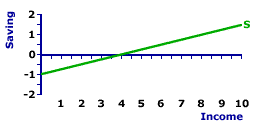
|
|
COIN: A shiny metal disc, almost always authorized by a national government entity, with a raised impression of famous dead people on one side and a building or birds on the other that is used as money. U.S. coins are issued by the U.S. Treasury Department and come in denominations of pennies, nickels, dimes, quarters, half-dollars, and dollars. At one time, metal coins were comprised of valuable metal (that is, commodity money) in an amount equivalent to their face value. A dime had 10-cents worth of silver. A nickel had 5-cents worth of nickel. A penney had 1-cents worth of copper. Most modern coins, however, are fiat money, containing less valuable metal alloys. But they work just fine in vending machines.
Visit the GLOSS*arama
|
|


|

|
                           DISSAVING: Another term for negative saving the occurs during a given period of time in which consumption expenditures exceed income. Dissaving is only possible by spending past or future income on current consumption. That is, using income saved from previous periods or borrowing income to be earned in future periods. Saving is generally illustrated by the vertical difference when between the consumption line and the 45-degree line. Dissaving results when the 45-degree line lies above the consumption line. Dissaving results when consumption is greater than income and is essentially the opposite of saving. Saving takes place when consumption is less than income. This unspent income is directed toward the financial markets (where it is then borrowed to finance other expenditures). For those doing the saving, this results in an increase in financial assets (that is, deposits in savings accounts) or a decrease in financial liabilities (that is, paying off loans).Dissaving occurs when funds are directed away from financial markets and used to pay for consumption expenditures in excess of income. For those doing the spending, this results in a decrease in financial assets (that is, withdrawals from savings accounts) or an increase in financial liabilities (that is, making new loans). In other words, current spending is financed with either past income (savings accounts) or future income (loans). | Saving Line |  | Consumption Line |  |
One easy way to identify dissaving is directly through the saving line, such as the green line, labeled S, in the top panel of the exhibit to the right. This saving line is positively sloped, ranging from -$1 trillion if income is zero, up to $1.5 trillion if income is $10 trillion. At $4 trillion of income saving equals zero as the saving line goes from negative to positive and crosses the horizontal axis.Saving (that is, positive saving) occurs for income levels exceeding $4 trillion. Over this range the saving line lies above the horizontal axis. In contrast, dissaving (that is, negative saving) takes place for income levels less than $4 trillion. Over this range the saving line lies below the horizontal axis. Another way to illustrate dissaving is through the consumption line, such as the red line, labeled C, in the bottom panel of the exhibit to the right. For reference, a black 45-degree line is also presented. The 45-degree line indicates all points in the exhibit in which consumption measured on the vertical axis is exactly equal to income measured on the horizontal axis. Because saving is the difference between income and consumption, this line also indicates all points in which saving is zero. Neither saving nor dissaving takes place on the 45-degree line. Best of all, this line can be used to identify saving, the difference between income and consumption. If the 45-degree line lies above the consumption line, such as what exists for income in excess of $4 trillion, then saving is positive. If the 45-degree line lies below the consumption line, which occurs for incomes less than $4 trillion, then saving is negative... and dissaving occurs. For the most part, dissaving in the macroeconomy is a theoretical extrapolation of the consumption-saving-income relation that occurs if income is low enough. Such a situation seldom arises. Individuals, however, frequently encounter dissaving. A typical consumer, such as Pollyanna Pumpernickel, who lives her life from paycheck to paycheck, is a car repair, hospital stay, or frozen water pipe away from dissaving. Should an unexpected expense arise, then her annual consumption expenditures are bound to exceed her annual income. The extra expense might be paid for out of previously accumulated savings (meager though they may be) or by charging up the balance on her credit cards (as maxed out as they may be). In either event, dissaving occurs.

Recommended Citation:DISSAVING, AmosWEB Encyclonomic WEB*pedia, http://www.AmosWEB.com, AmosWEB LLC, 2000-2024. [Accessed: May 15, 2024].
Check Out These Related Terms... | | | | | | | | | |
Or For A Little Background... | | | | | | | | | | | | |
And For Further Study... | | | | | | | | | | | | | |
Search Again?
Back to the WEB*pedia
|



|

|
PINK FADFLY
[What's This?]
Today, you are likely to spend a great deal of time wandering around the shopping mall trying to buy either a computer that can play music and burn CDs or a T-shirt commemorating last Friday (you know why). Be on the lookout for crowded shopping malls.
Your Complete Scope
This isn't me! What am I?
|

|
|
Ragnar Frisch and Jan Tinbergen were the 1st Nobel Prize winners in Economics in 1969.
|

|
|
"We succeed only as we identify in life, or in war, or in anything else, a single overriding objective, and make all other considerations bend to that one objective. " -- President Dwight D. Eisenhower
|

|
OCC
Options Clearing Corporation
|

|
|
Tell us what you think about AmosWEB. Like what you see? Have suggestions for improvements? Let us know. Click the User Feedback link.
User Feedback
|


|


